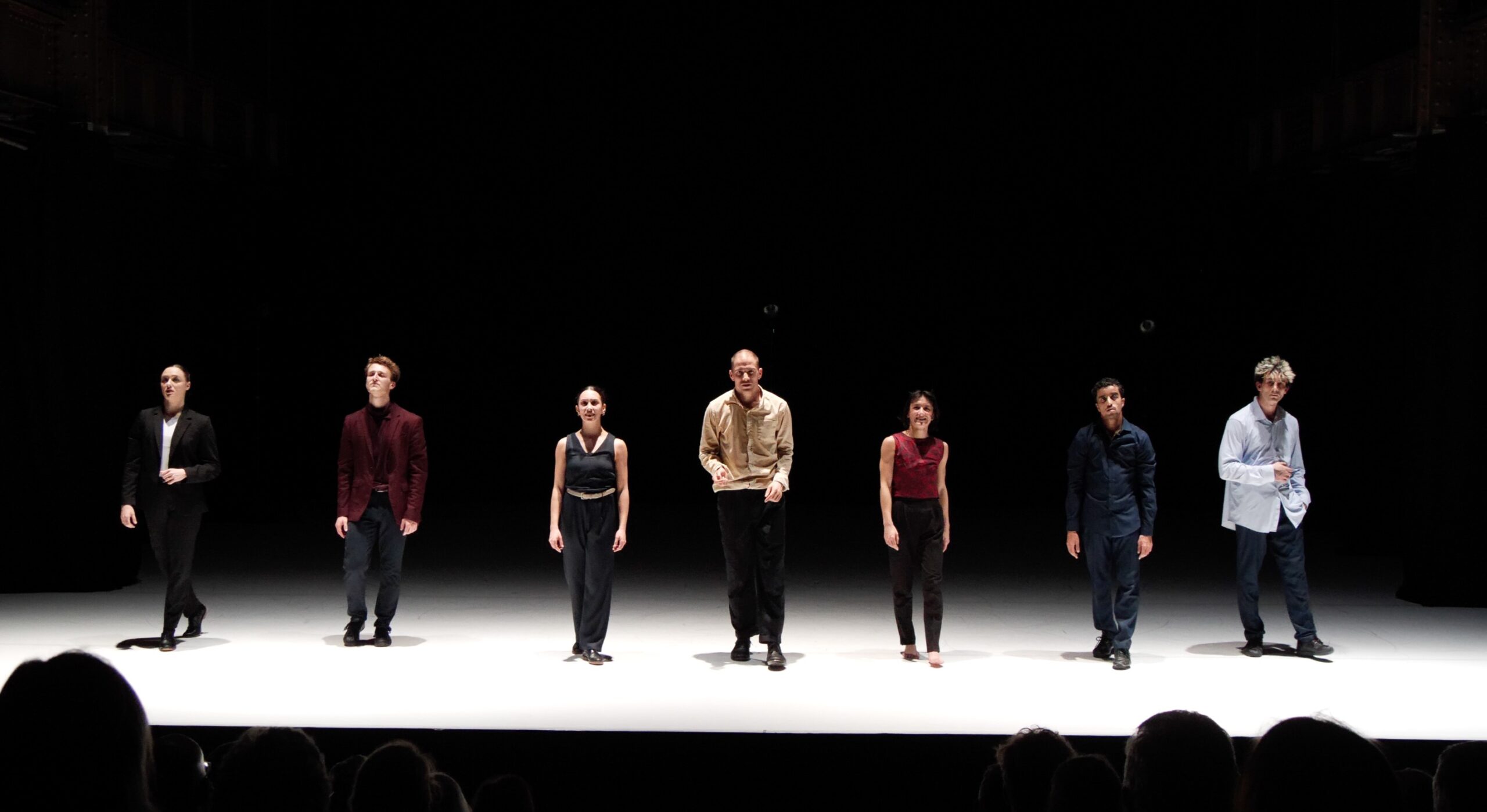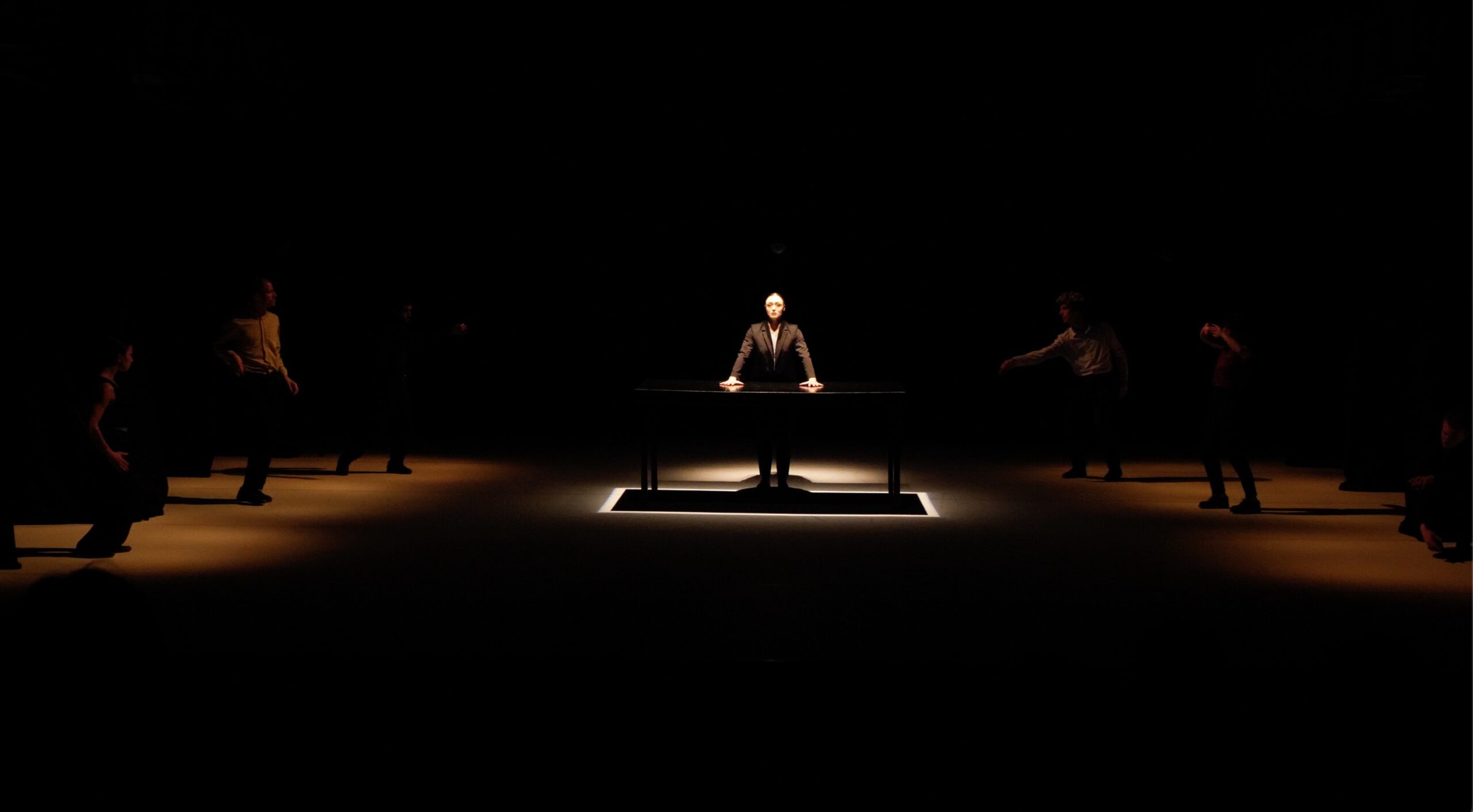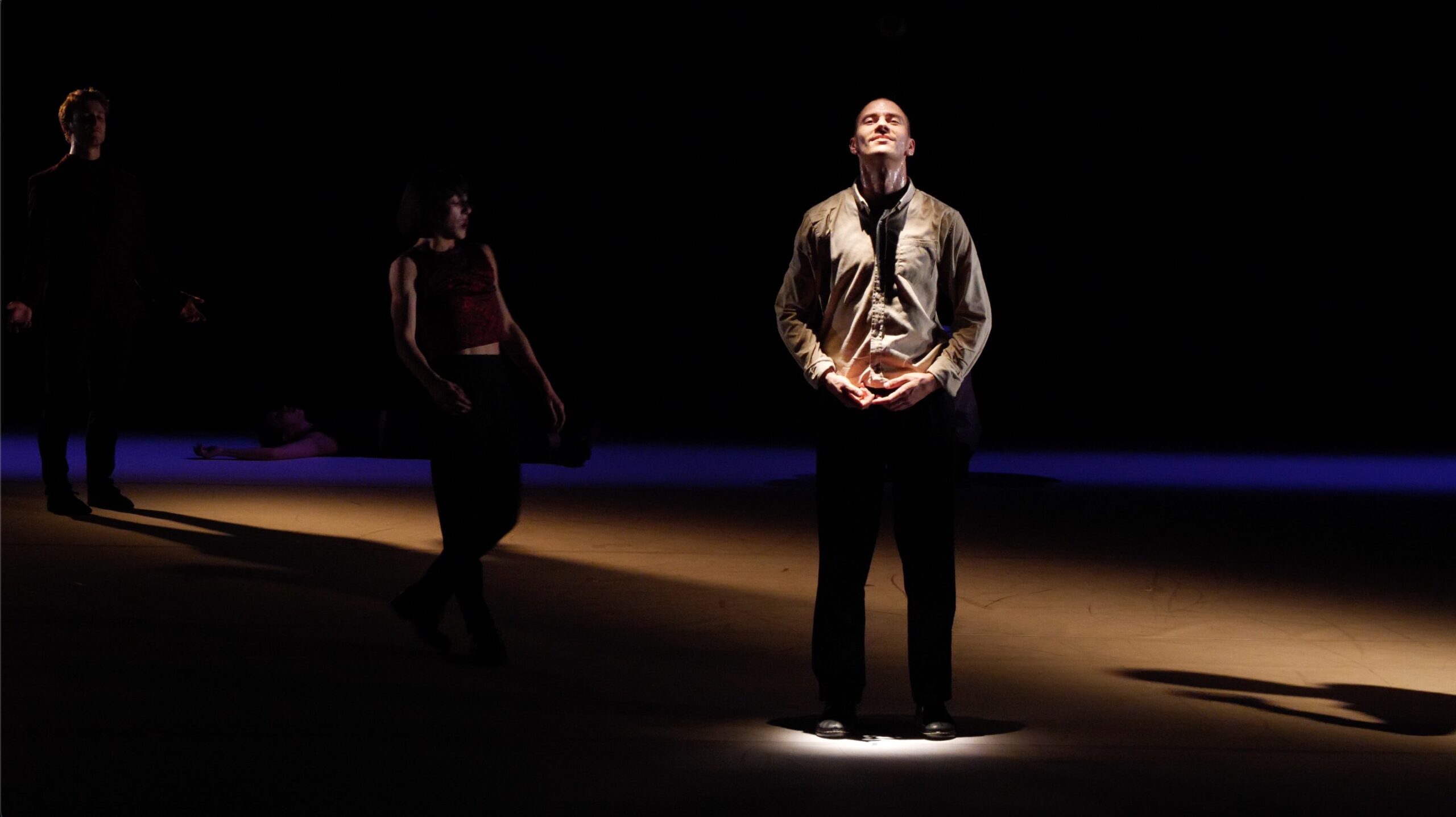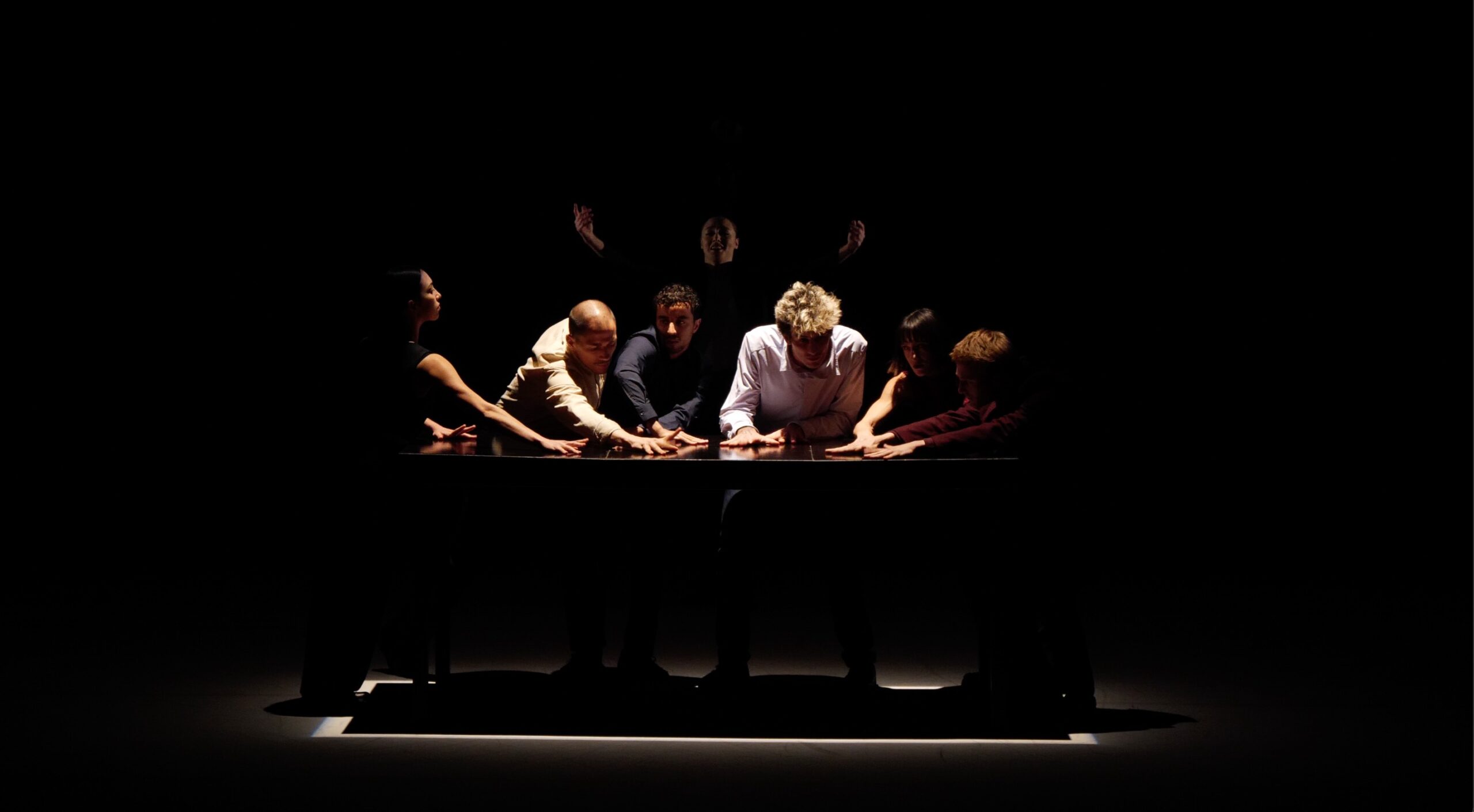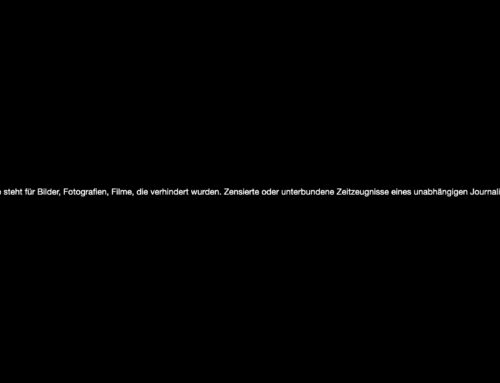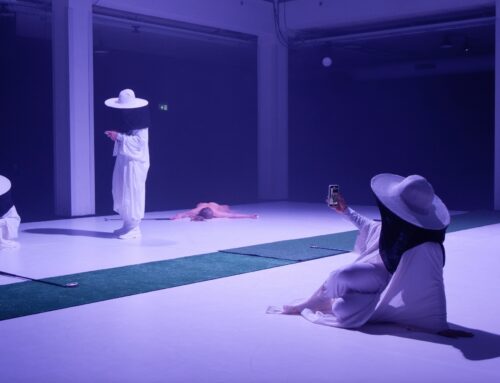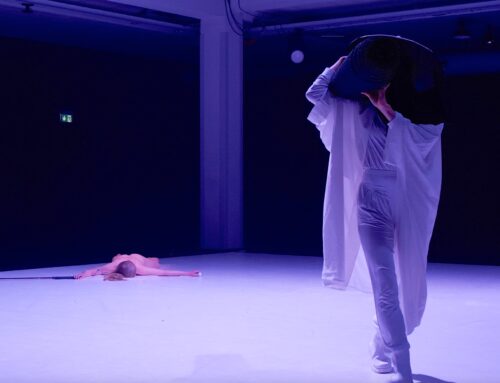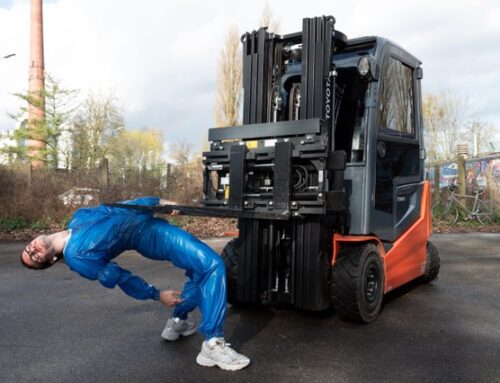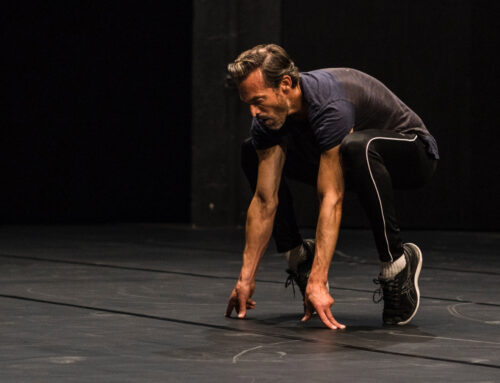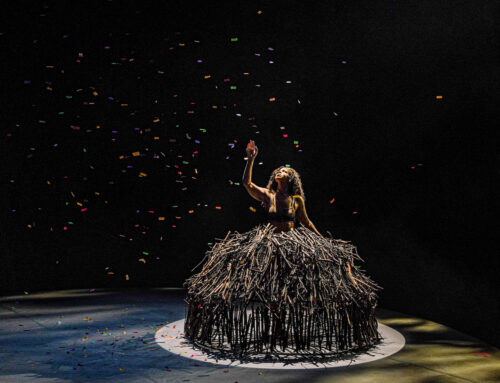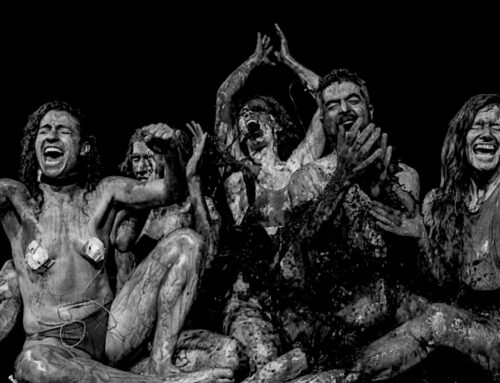It takes dust to stir up dust
The French company Dyptik from St Etienne gave a guest performance of „Dans l’engranage“ at the Stahlbau Strang factory in Aachen
by Melanie Suchy
After everything that later paraded across the stage in this piece from Stückwerke, joining together and separating again, appearing and leaving, whirling around on the floor, jumping and gobbling, dancing in circles, dancing within the circle, it is perhaps the outsiders, those who fall out and those who push ahead, the frontrunners, that remain in the memory. But certainly the opening scene.
The light creates a sculpture, slower than an hourglass. A sparkling glow from above, one on the ground. A head is glimpsed and two shoes can be seen on a brightly coloured square. Black in between. Alone in the dark room, the creature looks huge. Gradually shoulders can be seen, at some point a face, that of a woman with tightly tied back hair, her blazer and a line dividing her in two. Aha, a table top. The light-coloured fingers slide onto the tabletop, first crooked like claws, then flat. The standing woman holds the table or herself, she presses and maintains her stillness. She almost vibrates with exertion. But why this mysterious emergence from the darkness? What does it have to do with her unfolding as a speaker whose gestures claim grandiosity?
„Dans l’engrenage“, which premiered in 2017 and has since toured outside France with a varying cast, is puzzling. Again and again, it builds up scenes or little stories and makes them disappear. Switch on, switch off. The seven dancers seem like pawns, and the game is cold. As is the dance, even though it is delivered with great skill and virtuosity. The prize? Thunderous applause from the audience at the end. The choreography provoked it with a trick. A push of a button. So is it about mechanisms and control, based on the title, which means something like chain reaction? So the beginning was also just a power play. You watch, we train you.
Who is in charge?
This goddess of light in a business suit rattles off all kinds of oratorical gestures with pointed arms, a flexible upper body and a mask-like face, shredding the air around her, a knife without words. It always culminates in triumph, with one hand over her head and one in front of her body, her forearms half twisted, her fingers half spread, her chin raised. She repeats this at the table, later in the solitary spotlight at the edge of the stage like a wind-up figure. In an interesting way, this with the slightly bent arms – both forming an S – is also reminiscent of ballet, with the Sun King winking through the story. And the twisted wrist is reminiscent of Spanish dance. Finally: Charlie Chaplin’s Great Dictator spouting „Schnitzel“. It was at the table there too.
The dictator here, Alice Sundara, is joined by a crowd of six, who push and jerk their way out of the wings like cardboard cut-outs, then wipe their hands on the table, staple their fingers together, bend backwards, bend forwards, jab with their index fingers, rotate their seats, discuss the boss in the background. Now and again, others make a big deal of it, hijack the table, jump on it, tip it down or flick it over the edge in a cool manner.
Anyone who choreographs the behaviour of politicians at a large table cannot do without a certain other reference. In fact, choreographers Souhail Marchiche and Mehdi Meghari draw on Kurt Jooss‘ „Green Table“ from 1932, the most famous anti-war ballet. But their conference is busier, more unstable, and nobody shoots at the end. Instead, the table is pushed out and no story begins.
What then
But only fits of individuality. Individuals sometimes behave differently to others. It’s a banal idea, but it’s choreographically packaged quite skilfully so that it hardly seems like a number revue. Individuals get out of the group’s spin in one way or another. They stay behind or suddenly stop or rush ahead or squeeze into an existing line, showing different dance styles in solos. Everyone gets a turn, but after the strong intro, the men dominate.
Two of them are renowned b-boys, super experts in breakdancing, which they perform on the boards in some places. They spin on their backs, shoulders, hands or just one, twisting their legs around each other in the air or on the floor in endless variations. A dance that fills the smallest space with body, strength, curves and speed, and does not reach out into the distance. In the piece, it serves at times as an attempt to impress others, at other times to express the suffering and staggering of an outcast after the dancer has been pushed. The music thunders correspondingly low; the scene’s artificial theatricality is out of tune.
The same goes for the last solo, when a dancer who has never appeared before stands up in front with his arms raised. His stillness gradually brings the lively round dance at the back to a halt. He, in the spotlight, his face raised, smiles beatifically. Until, after a while, he begins to tremble with his arms and head, later his legs tremble too, and then his hands even wave. This is very reminiscent of Parkinson’s or other neurological loss of muscle control, completely out of place. When he releases the extreme tension, others wave their hands as if they were holding a handkerchief in a folklore dance.
In fact, in the second half of the piece, the choreographers cheer up their group of seven with traditional dances, small and wide quick steps from Middle Eastern cultures, in unison, as a crowd, as a row, as a circle, the shoes tap right, left, crosswise, the arms rise. Other styles mix in, bends, anything goes, and there doesn’t seem to be any real joy. Despite the mix, it’s a strangely smooth, polished surface. On the one hand, the way in which dance traditions and styles are appropriated and utilised to taste is very contemporary, but not a new approach either. On the other hand, it does not prevent „Dans l’engrenage“ from appearing hollow.

